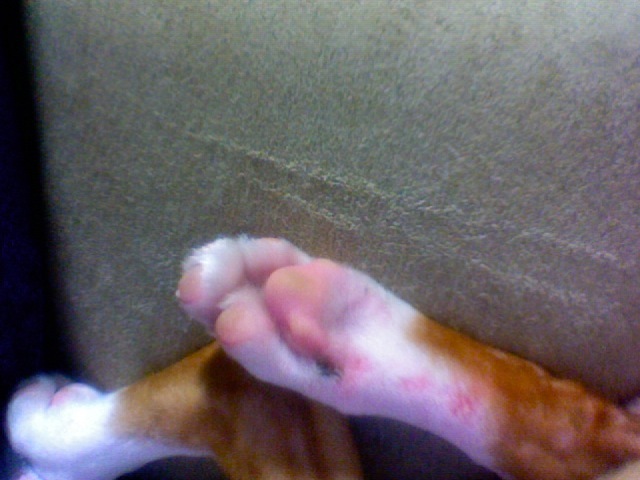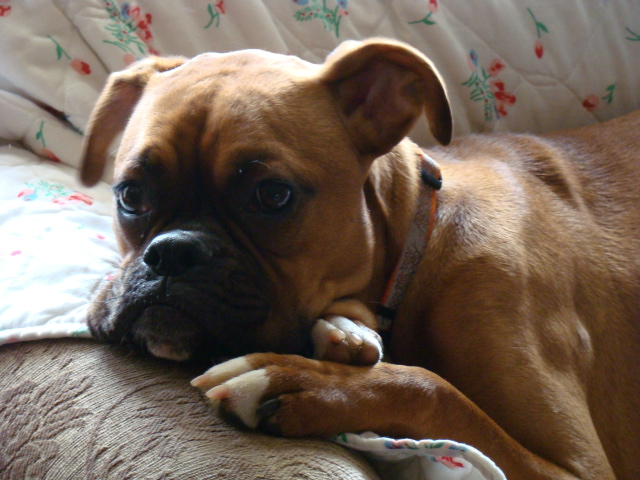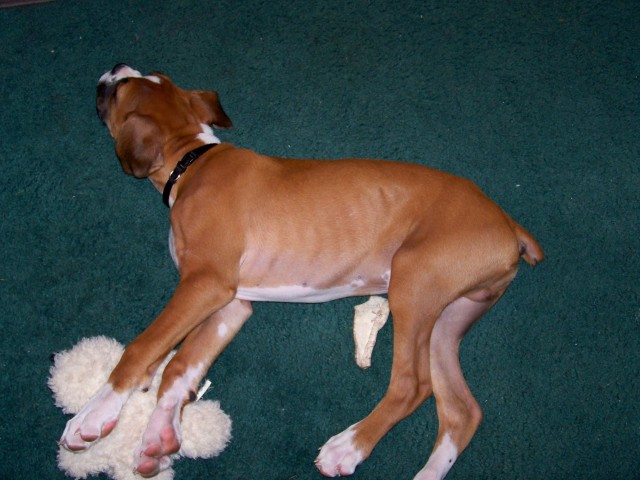QuestionHello, I have a 7.5 week old puppy and have a few questions.
1. What is the best food for her? She is 13.5 pounds and starting to beg for food from us. I feed her Merrick for puppies, 1/2 cup 3X a day. I was adding 1/4-1/3 can of puppy food, but it did not settle well, now I am adding 2 tablespoons of plain yogurt to her food. It seems to have settled her tummy, no more floppy stools. I had asked my vet about homemade food and she really wants me to wait until Allie is at least 1 year-old.
2. She is a typical boxer and has tons and tons of energy, then crashes because she is still a young puppy. So cute. I noticed in another post about daily walks, even at this young age. What are the best methods of training her to walk on a leash, she is just a baby, but if I wait until she is to much older she will be walking me!
3. Our vet wants us to wait until she has her second set of shot to begin formal puppy classes, what should I look for in a good basic class?
Thanks for your help!
AnswerHi Shane,
1. The best food is variable, it depends on what works for the dog, your budget, and your lifestyle. :) Merrick is generally considered a high quality food so I'd say if it's working for her (with the adjustments you've made) you're on the right track. There are many puppies who are fed homemade foods and thrive, but you have to do what your comfort level dictates; there is a very thorough resource on dog feeding which includes quite a bit of information on homemade diets here, for when (if) you do decide to make that change:
http://www.dogaware.com/dogfeeding.html
2. There are many different methods for teaching leash walking; the first thing is just to get her used to being on a collar and leash, if she's not already. That usually entails putting the collar on and letting her go about her normal routine with it on (be aware of choking hazards and never leave it on her unattended or in a crate); then you can attach the leash and let her drag it around (and probably pick it up in her mouth and play with it!); then hold on to the leash but just follow her - don't dictate where you go. (You can do this in the house or in a fenced yard; better not to do it in an open area because she may take off on you!) The next step - or if she's hesitant to move at all if you're holding the leash - is to get her to follow you; often this requires some really super yummy food. Reward heavily, even 2-3 steps with a loose leash is a major accomplishment at this point.
Once she's used to being on-lead you can work on keeping it loose - for some dogs it's as easy as rewarding a loose leash on an increasing basis - 2 steps, 5 steps, 10 steps, the sidewalk, the driveway, etc.; for others, they need a bit more information about what you want and what you don't. The "Be A Tree" method is a popular one; basically, if the dog puts tension on the leash, you stop and don't move until the leash goes slack again (or, some set it so that the dog must look at them or even return to them). This is combined with rewarding for loose leash, and teaches the dog that pulling at the leash doesn't get them anything they want. (For more dedicated pullers, a method called "Penalty Yards" can be quite successful - but she's not at that point yet!)
A couple of good articles on various loose leash walking techniques are here:
http://www.clickersolutions.com/articles/2001/lltotal.htm
http://www.clickertraining.biz/nopull.htm (Penalty Yards)
Be careful of too much walking as a puppy, though - it can actually cause problems with her growth plates (growth plates don't close until around 18 months of age). One rule of thumb is five minutes of leash walking for every age in months. She can basically run around as much as she likes - it's the repetitive "pounding" on the joints of walking or jogging that can be problematic.
3. You definitely want to observe some classes before you sign up; a good class is one that teaches the owner to teach the dog, so you want to see a trainer who is watching for owners that are having difficulties and helping them out on an individual basis (without taking too much away from the rest of the class). With a puppy, you don't really want to be too formal; a "puppy kindergarten" or socialization class is more appropriate - these are basically 'play groups' with some short sessions of training and lots of instruction for the owners on basic training to do at home as the puppy ages, as well as various other dog-ownership topics. Boxers tend to respond best to operant-based training (such as clicker training) rather than compulsion-based training (leash corrections, squirt bottles, etc.); they are an intelligent breed and prefer to think things through. There are some listings of trainers by state at these sites:
www.clickerteachers.net
www.nadoi.org
www.apdt.com
Good luck!!

 Boxer puppy hind legs bleeding
QuestionBoxer Hind leg
QUESTION: I have a 14 wee
Boxer puppy hind legs bleeding
QuestionBoxer Hind leg
QUESTION: I have a 14 wee
 My dogs paw
Question
bucks paw
I have a boxer that is a little over
My dogs paw
Question
bucks paw
I have a boxer that is a little over
 Aggressiveness
QuestionTaylor
QUESTION: Good morning Jannie,
W
Aggressiveness
QuestionTaylor
QUESTION: Good morning Jannie,
W
 Deaf puppy ?
Question
Paloma (white dove)
I have a 9 week old
Deaf puppy ?
Question
Paloma (white dove)
I have a 9 week old
 Puppys weight.
Question
Champ at 12 weeks.
Hello,
I wanted some infor
Puppys weight.
Question
Champ at 12 weeks.
Hello,
I wanted some infor